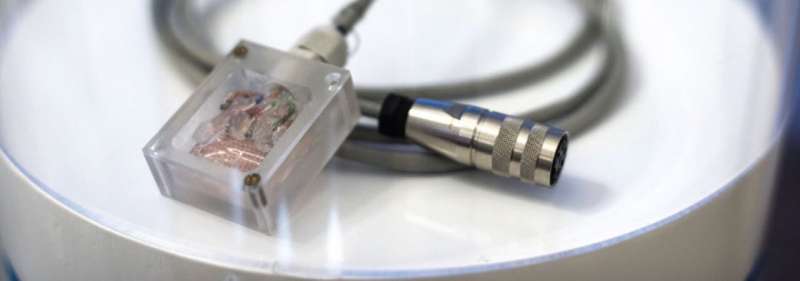Home » Health News »
Researchers present an ultra-precise brain imaging tool

A joint team from the Russian Quantum Center, Skoltech, and the Higher School of Economics has presented a novel supersensitive solid-state magnetometer operating at room temperature. The researchers for the first time used it to detect and record brain electrical activity with a technique called magnetoencephalography, which could become dozens of times cheaper with the new device. The paper was published in Human Brain Mapping.
High accuracy is a key advantage of magnetoencephalography (MEG) over other similar techniques used for studying the electrical activity of the brain. Biological tissues are transparent for magnetic fields. However, only a very limited number of laboratories around the world have MEG equipment, which uses either extremely cold liquid helium or high-temperature gas and is very expensive and difficult to manufacture.
A team from the Russian Quantum Center (RQC) developed a new sensor using yttrium-iron garnet films. This is the first solid-state supersensitive room-temperature magnetometer in the world. It is based on a quantum sensor and is capable of registering very weak or deep electrical sources in the brain. Owing to its wide dynamic range, the device requires less magnetic shielding, which means a lower cost of both the hardware and the entire research infrastructure.
To test the new type of sensor in action, Skoltech and Higher School of Economics researchers performed an experimental study, measuring a simple brain induced field—the alpha rhythm—which constitutes sinusoidal electric currents in the back of the brain. The new sensor successfully detected the onset of alpha rhythm, and the result was validated by other methods.
In the future, the team plans to study various sensor configurations, including a flexible band-type device placed around a patient’s head to ensure the utmost efficiency and accuracy in detecting the exact location of electrical activity in the cerebral cortex. The current findings call for further exploration of the technology and a step-by-step development of an MEG device based on solid-state sensors, which will mark an important step forward in noninvasive neuroimaging and neurointerfaces.
“The initial concept of this sensor was proposed by the project engineering lead, Pyotr Vetoshko, back in the mid-1990s. Currently, there is a steadily growing interest in MEG systems across the world, as confirmed by key market figures: The MEG market, which was estimated at $600 million in 2017 is expected to reach $1.3 billion by 2025. Although our quantum device and the classical flux-gate sensor have similar operating principles, in our case, the quantum exchange interaction helped detect a magnetic field with a magnitude 1,000 times lower compared to conventional solutions. Moreover, its high sensitivity coupled with all the advantages of classical flux-gate sensors makes our device a truly universal magnetometer ideally suited for brain research,” Maxim Ostras, the head of the project at RQC, says.
“Even the first prototype of the sensor in some cases showed higher sensitivity in MEG as compared to existing systems, which, combined with its simplicity and solid-state nature, suggests that systems based on this technology have a bright future ahead of them. Of course, there is still a lot of work to be done, including further research into the physical properties of the sensor and the development of a new mathematical apparatus that will ensure high-efficiency signal processing for this new specific type of magnetometer,” Assistant Professor Nikolay Koshev of Skoltech comments.
Source: Read Full Article



